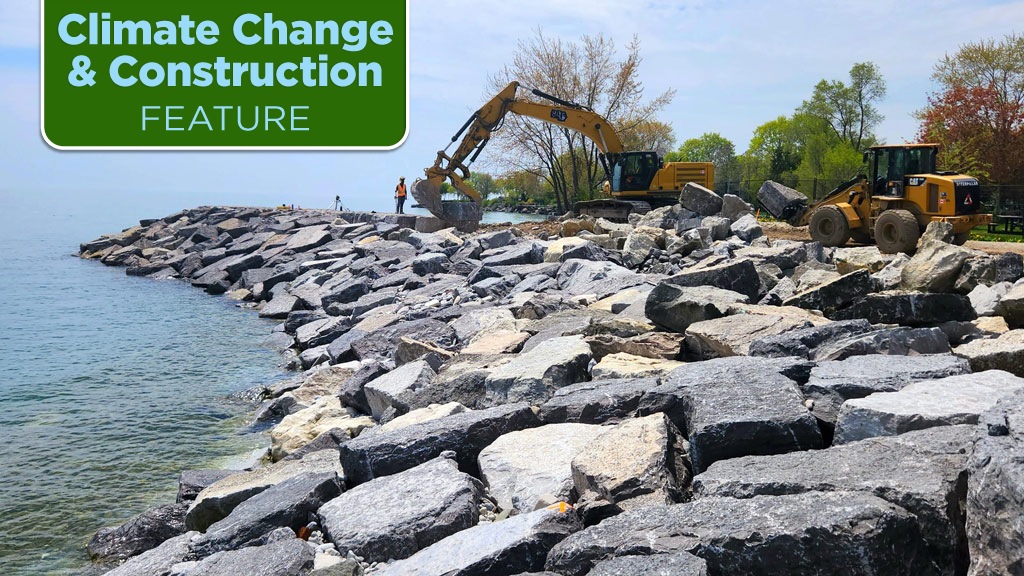Climate change and extreme flooding have been catalysts for a series of Toronto and Region Conservation Authority (TRCA) shoreline protection projects based on updated 100-year flood level recommendations.
The third such project is currently underway on the shores of Lake Ontario in the west end of Toronto where a small TRCA construction crew has been working hard in all sorts of weather since last October.
Using a 336 Cat excavator, a 930 Cat loader and a 299 Cat skidsteer with a sweeper attachment, the crew is erecting a new and significantly enhanced shoreline protection structure at Prince of Wales Park.
Scheduled for completion this September, the $2.8-million project is comprised of a number of design and building improvements over the previous failed protection system.
Designed by the TRCA, it will be built to a height of 78.5 metres, which is considerably higher than the old structure and will also consist of larger armourstone and other materials.
A double layer, compared to the original single layer, of three-to-five tonne armourstone is being installed at the groyne structure and two-to-four tonne armourstone along the revetment. The groyne is the perpendicular point, while the revetment is the structure protecting the embankment.
There will also be a wider splash pad behind the crest to reduce the impact of waves overtopping the slope, preventing erosion, says TRCA senior risk manager Jet Taylor.
“We have generally been building (shoreline) building structures to a greater resiliency than originally built during all our maintenance projects.”
Driving that initiative is predicted climate change patterns coupled with severe flooding a few years ago.
In 2017, and then again in 2019, a series of storms raised the level of Lake Ontario causing considerable flooding and erosion.
Those conditions were particularly severe in the Toronto area with its high density and development close to the lake. The Toronto Islands, a popular day-trip park destination attracting thousands of visitors, were particularly hard hit by flooding and many businesses catering to those visitors had to close.
Following those events, the TRCA asked the coastal engineering firm of Baird Engineering to undertake a “flood characterization study.”
Using almost 60 years of measured water levels from 1962 to 2019 and plan changes by the International Joint Commission, the body that approves projects that affect water levels and flows across the Canada/United States boundary, the consultant recommended the 100-year flood level design criteria in the Toronto area be increased from 75.74 to 76.2 metres.
A 100-year flood is defined as a flood that statistically has a one-per cent chance of occurring in any given year.
“This (increased level) is generally what we now use as our design level when we consider shoreline protection projects,” says Taylor, emphasizing it is a baseline starting point.
Each project must be evaluated and designed according to the specific characteristics of the area taking into account factors such as wave speed and depth.
In the case of Prince Wales Park, its priority was given a high ranking. Built in the 1970s, its previous protection system had deteriorated over time due to continuous wave activity and that failure was exacerbated by the 2017 and 2019 high water levels as well as a major windstorm in April 2018, says Taylor.
As for the actual construction, there are more than a few challenges, says project manager Rebecca Salvatore.
Although the new engineered structure will be larger than the old existing revetment, the TRCA crew is reusing all armour pieces that meet the new specifications, while the smaller stones are being utilized as rip rap base stone.
Tying in the new structure into the existing one, “requires a common sense approach, a good engineering support team, a good operator and supervision so that we don’t damage anything and create more work.”
Armour revetment work requires an experienced crew from operators to supervisors knowing how to select the right stone to fit the structure together, she says.
Then there were the challenges of dealing with mud in the staging area and working in all weather conditions all year round. The old revetment was dismantled and the stones used to create a break wall near the water for safety.
“Winter conditions are always a challenge with ice, high winds/waves crashing in at times forcing us to work from top of bank during those days,” says Salvatore.



Recent Comments
comments for this post are closed